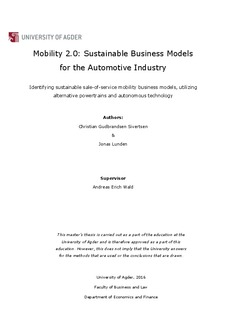| dc.contributor.author | Sivertsen, Christian Gudbrandsen | |
| dc.contributor.author | Lunden, Jonas | |
| dc.date.accessioned | 2016-11-02T14:23:33Z | |
| dc.date.available | 2016-11-02T14:23:33Z | |
| dc.date.issued | 2016 | |
| dc.identifier.uri | http://hdl.handle.net/11250/2419068 | |
| dc.description | Master thesis Business Administration BE501 - University of Agder 2016 | nb_NO |
| dc.description.abstract | The aim of this study is to identify and develop sustainable mobility business models (BMs) for the automotive industry. This is a response to an analysis of the opportunities and limitations of new technology and carsharing BMs occurring alongside emerging industry challenges. The traditional automotive industry BM has remained, thereabouts, unchanged for more than a century. Exploration in this paper determines that to enable future sustainability, industry changes must occur. The current traditional BM is struggling with changing market characteristics and appears inadequate to adopt new environmental technologies (e.g. electric vehicle, autonomous and hydrogen powered cars).
The utilization of a literature analysis approach enables the execution of a highly up-to-date and comprehensive investigation. Literature is used to help identify current industry challenges and present emerging technologies that new BMs need to successfully resolve and utilize respectively. This thesis paper further presents and explores the essential BM theories used in analysis and BM generation. Moreover, there is focus on solving the unsustainability of car ownership, such as by equipping a sale-of-service approach used by carsharing services in order to develop sustainable mobility BMs. The main focus of this thesis is the analysis of opportunities and limitations that identify features necessary for sustainable mobility BMs.
The main findings are two different mobility BMs, which we argue are adequate in concern to the adoption of new technologies and are advantageous in relation to the industry challenges. This thesis presents an autonomous BM that is applicable for urban, densely populated areas, and operates like today’s free-floating carsharing services. The second sustainable BM found in this study utilized the sale-of-service characteristics of carsharing, operating in a similar fashion as regular ownership. The analysis is thereby used to develop one BM for autonomous, urban carsharing and one BM for a sustainable ownership-substitute. Both models adopt electric or hydrogen fuel-cell power train technology and utilize the industry challenges as opportunities for growth. | nb_NO |
| dc.language.iso | eng | nb_NO |
| dc.publisher | Universitetet i Agder ; University of Agder | nb_NO |
| dc.subject | BE501 | |
| dc.title | Mobility 2.0: Sustainable Business Models for the Automotive Industry : Identifying sustainable sale-of-service mobility business models, utilizing alternative powertrains and autonomous technology | nb_NO |
| dc.type | Master thesis | nb_NO |
| dc.subject.nsi | VDP::Social science: 200::Economics | nb_NO |
| dc.source.pagenumber | VII, 109 p. | nb_NO |
